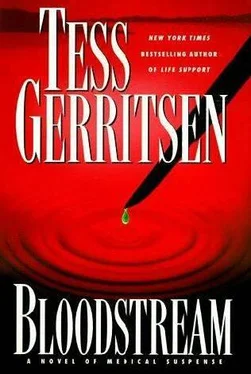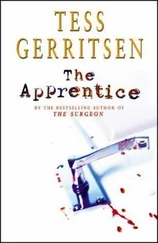“After you left my office,” he said, “I got to thinking about what you’d said.
That there’s a pattern to the violence in this town. That there’s some sort of connection between 1946 and this year.” He reached in his jacket and took out the sheaf of photocopied news articles she’d left him. “Guess what? The answer was staring right at us?’
“What answer?”
“Look at the first page. The October issue, 1946.”
“I’ve already read that article.”
“No, not the story about the murder. The article at the bottom. You probably didn’t notice it.”
She smoothed the page on her lap. The article he’d referred to was partly cut off; only the top half had been included in the photocopy.
The headline read: REPAIRS ON LOCUST RIVER BRIDGE COMPLETED.
“I don’t know what you’re getting at,” she said.
“We had to repair that same bridge this year. Remember?”
“Yes.”
“So why did we have to repair it?”
“Because it was broken?”
He ran his hand through his hair in frustration. “Geez, Claire. Think about it!
Why’d the bridge need repairs? Because it got washed away We had record rainfall this past spring, and it flooded the Locust River, washed out two homes, tore out a whole series of footbridges. I called the U.S. Geological Survey to confirm it. This year was the heaviest rainfall we’ve had in fifty-two years.”
She looked up, suddenly registering what he was trying to tell her. “Then the last time the rainfall was this heavy.
“Was the spring of 1946.”
She sat back, stunned by the coincidence. “Rainfall,” she murmured. “Moist soil.
Bacteria. Fungi.
“Mushrooms are fungi. What about those blue ones?”
She shook her head. “Max had their identity confirmed. They’re not very toxic.
But heavy rains would encourage the growth of other fungi. In fact, it’s a fungus that caused mass occurrences of St. Vitus’ dance.”
“Is that a seizure?”
“The medical term for St. Vitus’ dance is chorea. It’s a writhing, dancelike movement of the limbs. Occasionally, there’ll be reports of mass occurrences. It may even have inspired the witchcraft accusations in Salem.”
“A medical condition?”
“Yes. After a cold, wet spring, rye crops can be infected by this fungus. People eat the rye, and they develop chorea.”
“Could we be dealing with a form of St. Vitus’ dance?”
“No, I’m just saying there are examples throughout history of human diseases linked to climate. Everything in nature is intimately bound together. We may think we control our environment, but we’re affected by so many organisms we can’t see.” She paused, thinking about Scotty Braxton’s negative cultures. So far nothing had grown out from either his blood or spinal fluid. Could there be a locus of infection she had missed? An organism so unusual, so unexpected, the lab would have discounted it as error?
“There must be a common factor among these children,” she said. “Exposure to the same contaminated food, for instance. All we have is this apparent association between rainfall and violence. It could be just coincidence.”
He sat in silence for a moment. She had often studied his face, admiring the strength she saw there, the calm self-confidence. Today she saw the intelligence in his eyes. He had taken two completely disparate bits of information and had recognized a pattern that she had not even noticed.
“Then what we need to find,” he said, “is the common factor.”
She nodded. “Could you get me into the Maine Youth Center? So I can talk to Taylor?”
“That could be a problem. You know Paul Darnell still blames you?’
“But Taylor’s not the only child affected. Paul can’t blame me for everything else that’s gone wrong in this town.”
“Not now, he can’t.” Lincoln rose to his feet. “We need answers before the town meeting. I’ll get you in to see the boy, Claire. One way or another.”
Standing at the parlor window, she watched him walk down the icy driveway to his truck. He moved with the balanced stride of a man who’d grown up in this unforgiving climate, each step planted squarely, the boot sole stamped down to catch the ice. He reached the truck, opened the door, and for some reason glanced back at her house.
Just for an instant, their gazes met.
And she thought, with a strange sense of wonder, How long have I been attracted to him? When did it start? I can’t remember. Now it was one more complication in her life.
As he drove away, she remained at the window, staring at a landscape bled of all color. Snow and ice and bare trees, all of it fading to black.
Upstairs, Noah’s music had started again.
She turned from the window and flicked off the parlor lamp. That’s when she suddenly remembered the promise she’d made to Warren Emerson, and she groaned.
The cat.
Night had fallen by the time she drove up the lower slope of Beech Hill and pulled into Emerson’s front yard. She parked next to the woodpile, a perfectly circular tower of stacked logs. She thought of the many hours it must have taken him to arrange his wood with such precision, each log placed with the same care one usually gave to constructing a stone wall. And then to pull it down again, bit by bit, as winter consumed his annual work of art.
She turned off her engine and looked up at the old farmhouse. No lights were on inside. She used a flashlight to guide herself up the icy front steps to the porch. Everything seemed to sag and she had the strange illusion that she was tilting sideways, sliding toward the edge, toward oblivion. Warren had told her the door would be unlocked, and it was. She stepped inside and turned on the lights.
The kitchen sprang into view with its worn linoleum and chipped appliances. A small gray cat stared up at her from the floor. They had startled each other, she and the cat, and for a few seconds they both froze.
Then the cat shot out of the room and vanished somewhere into the house.
“Here, kitty kitty! You want your dinner, don’t you? Mona?”
She had planned to take Mona to a kennel for boarding. Warren Emerson had already been transferred to Eastern Maine Medical Center for his craniotomy, and would remain hospitalized for at least a week. Claire didn’t relish the thought of driving here every day just to feed a cat. But it appeared the cat had different ideas.
Her frustration mounted as she went from room to room in search of the uncooperative Mona, turning on lights as she went. Like so many other farmhouses of its era, this one had been built to house a large family, and it consisted of many small rooms, made even more claustrophobic by the clutter. She saw piles of old newspapers and magazines, bundled grocery sacks, crates filled with empty bottles. In the hallway she had to turn sideways to navigate a narrow tunnel between stacked books. Such hoarding was usually a sign of mental illness, but Warren had organized his clutter in a logical fashion, the books segregated from the magazines, the brown paper bags all folded and bound together with twine.
Perhaps this was merely Yankee frugality carried to an extreme.
It provided plenty of cover for a fugitive cat.
She’d made a complete circuit of the downstairs without spotting Mona. The cat must be hiding in one of the upstairs rooms.
She started up the steps, then halted, her hands suddenly sweating. Deja vu, she thought. I have lived this before. A strange house, a strange staircase.
Something terrible waiting for me in the attic.
But this was not Scotty Braxton’s house, and the only thing lurking upstairs was a frightened animal.
She forced herself to continue climbing as she called out, “Here, kitty!” if only to prop up her faltering courage. There were four doors on the second floor, but only one was open. If the cat had fled upstairs, she had to be in that room.
Читать дальше
Конец ознакомительного отрывка
Купить книгу












